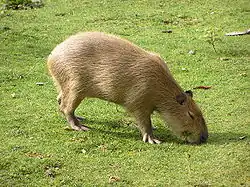豪猪亚目
豪猪亚目(学名:Hystricomorpha)在历史上曾有过许多含义。广义上是指所有具有豪猪型颧弓-咬肌结构(Zygomasseteric system)的啮齿目动物(跳鼠类除外),包括豪猪下目(Hystricognathi)、栉趾鼠科(Ctenodactylidae)、鳞尾松鼠科(Anomaluridae)、跳兔科(Pedetidae)。分子及形态学研究表明,将鳞尾松鼠科与跳兔科列入其中是有争议的。根据Carleton与Musser的研究[1],这两科被分为鳞尾松鼠亚目(Anomaluromorpha)。
| 豪猪亚目 化石时期:始新世–现代 | |
|---|---|
 | |
| 水豚 Hydrochoerus hydrochaeris | |
| 科学分类 | |
| 界: | 动物界 Animalia |
| 门: | 脊索动物门 Chordata |
| 纲: | 哺乳纲 Mammalia |
| 目: | 啮齿目 Rodentia |
| 亚目: | 豪猪亚目 Hystricomorpha Brandt, 1855 |
| 下目 | |
| |
豪猪亚目(又被称为Entodacrya或Ctenohystrica)的现代定义是指将栉趾鼠与豪猪下目联系起来的分类学假设。[1]支持这一说法有很多形态学以及分子系统发生学的证据。如果此假说是真实的,那传统观点中的松鼠形亚目将被推翻,成为一个并系群。
豪猪类动物,或至少是豚鼠小目中的成员,有时会被认为是非啮齿类。[2][3][4]不过大多数分子与遗传学研究都表明啮齿动物是单系群。[5][6][7][8][9][10]而支持啮齿类为多系群的证据被认为是源自长枝吸引(long branch attraction)的现象。[11]
豪猪类动物于渐新世早期出现于南美洲[12],这里此前的陆地哺乳动物只有后兽下纲、贫齿总目、南蹄目。豪猪类是从非洲横渡大西洋到达南美洲的。同一类型的迁徙还发生在灵长目中,这些都发生于南北美洲生物大迁徙之前。不过这些说法至今尚存争议。
分类
以下的分类是根据Marivaux等人对早期啮齿类化石进行的支序分类学分析而来的。[13][14]他们的研究支持豪猪亚目假说,并表明McKenna与Bell定义的先松鼠亚目(Sciuravida)[15]是多系群,因而并不成立。
- 豪猪亚目 Hystricomorpha
- 梳齿鼠总科 Ctenodactyloidea
- 梳齿鼠科 Ctenodactylidae
- †科 Tammquammyidae
- 硅藻鼠科 Diatomyidae
- †豫鼠科 Yuomyidae
- †馕鼠科 Chapattimyidae
- 演化支 Hystricognathiformes
- 梳齿鼠总科 Ctenodactyloidea
- Carleton and Musser, 2005
- Graur et al., 1991
- D'Erchia et al., 1996
- Reyes et al., 2000
- Cao et al., 1994
- Kuma and Miyata, 1994
- Sullivan and Swofford, 1997
- Robinson-Rechavi et al., 2000
- Lin et al., 2002
- Reyes et al., 2004
- Bergsten, 2005
- Flynn et al., 2003
- Marivaux et al., 2002
- Marivaux et al., 2004
- McKenna and Bell, 1997
参考文献
| 维基共享资源中相关的多媒体资源:豪猪亚目 |
| 维基物种中的分类信息:豪猪亚目 |
- Bergsten, J. 2005. A review of long-branch attraction. Cladistics, 21:163-193.
- Cao, Y., Adachi, J., Yano, T. and Hasegawa, M. 1994. Phylogenetic place of guinea pigs: No support of the rodent-polyphyly hypothesis from maximum-likelihood analyses of multiple protein sequences. Molecular Biology and Evolution, 11: 593-604.
- Carleton, M. D. and G. G. Musser. 2005. Order Rodentia. Pp745–752 in Mammal Species of the World A Taxonomic and Geographic Reference (D. E. Wilson and D. M. Reeder eds.). Baltimore, Johns Hopkins University Press.
- D'Erchia, A., Gissi, C., Pesole, G., Saccone, C. and Arnason, U. 1996. The guinea-pig is not a rodent. Nature, 381 (6583): 597-600.
- Flynn, J. J., Wyss, A. R., Croft, D. A., and Charrier, R. 2003. The Tinguiririca Fauna, Chile: biochronology, paleoecology, biogeography, and a new earliest Oligocene South American Land Mammal ‘Age’. Palaeogeography, Palaeoclimatology, Palaeoecology, 195:229-259.
- Graur, D., Hide, W. and Li, W. 1991. Is the guinea-pig a rodent? Nature, 351: 649-652.
- Huchon, D. E. J. P. Douzery. 2001. From the Old World to the New World: A molecular chronicle of the phylogeny and biogeography of hystricognath rodents. Molecular Phylogenetics and Evolution, 20:238-251.
- Kuma, K. and Miyata, T. 1994. Mammalian phylogeny inferred from multiple protein data. Japanese Journal of Genetics, 69 (5): 555-66.
- Landry, S. O. J. 1999. A proposal for a new classification and nomenclature for the glires. Mitt. Mus. Nat. Kd. Berl. Zool. Reihe, 75:283-316.
- Lin, Y-H, et al. 2002. Four new mitochondrial genomes and the increased stability of evolutionary trees of mammals from improved taxon sampling. Molecular Biology and Evolution, 19: 2060-2070.
- Marivaux, L., M. Vianey-Liaud, and J.-J. Jaeger. 2004. High-level phylogeny of early Tertiary rodents: dental evidence. Zoological Journal of the Linnean Society, 142:105-134.
- Marivaux, L. J. L. Welcomme, M. Vianey-Liaud, and J.J. Jaeger. 2002. The role of Asia in the origin and diversification of hystricognathous rodents. Zoologica Scripta, 31:225-239.
- McKenna, Malcolm C., and Bell, Susan K. 1997. Classification of Mammals Above the Species Level. Columbia University Press, New York, 631 pp. ISBN 0-231-11013-8
- Reyes, A., Pesole, G. and Saccone, C. 2000. Long-branch attraction phenomenon and the impact of among-site rate variation on rodent phylogeny. Gene, 259 (1-2): 177-87.
- Reyes, A., Gissi, C., Catzeflis, F., Nevo, E. Pesole, G. and Saccone, C. 2004. Congruent mammalian trees from mitochondrial and nuclear genes using Bayesian methods. Molecular Biology and Evolution, 21 (2): 397-403.
- Robinson-Rechavi, M., Ponger, L. and Mouchiroud, D. 2000. Nuclear gene LCAT supports rodent monophyly. Molecular Biology and Evolution, 17: 1410-1412.
- Sullivan, J. and Swofford, D.L. 1997. Are guinea pigs rodents? the importance of adequate models in molecular phylogenetics. Journal of Mammalian Evolution, 4: 77-86.
This article is issued from Wikipedia. The text is licensed under Creative Commons - Attribution - Sharealike. Additional terms may apply for the media files.